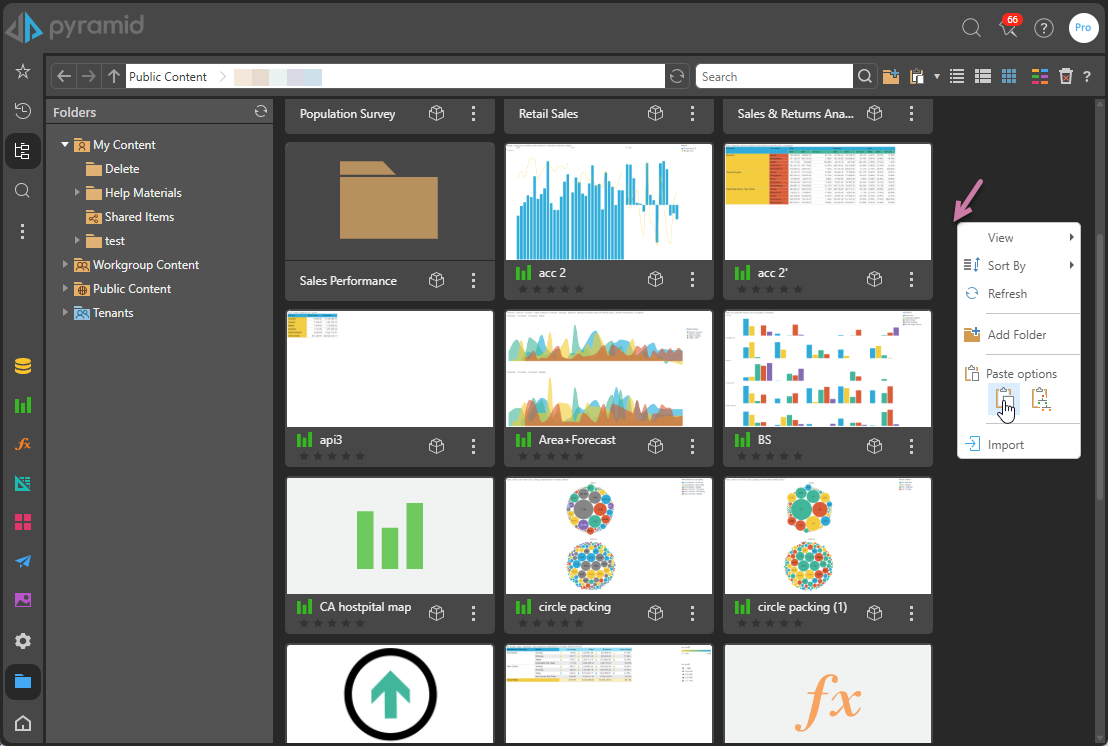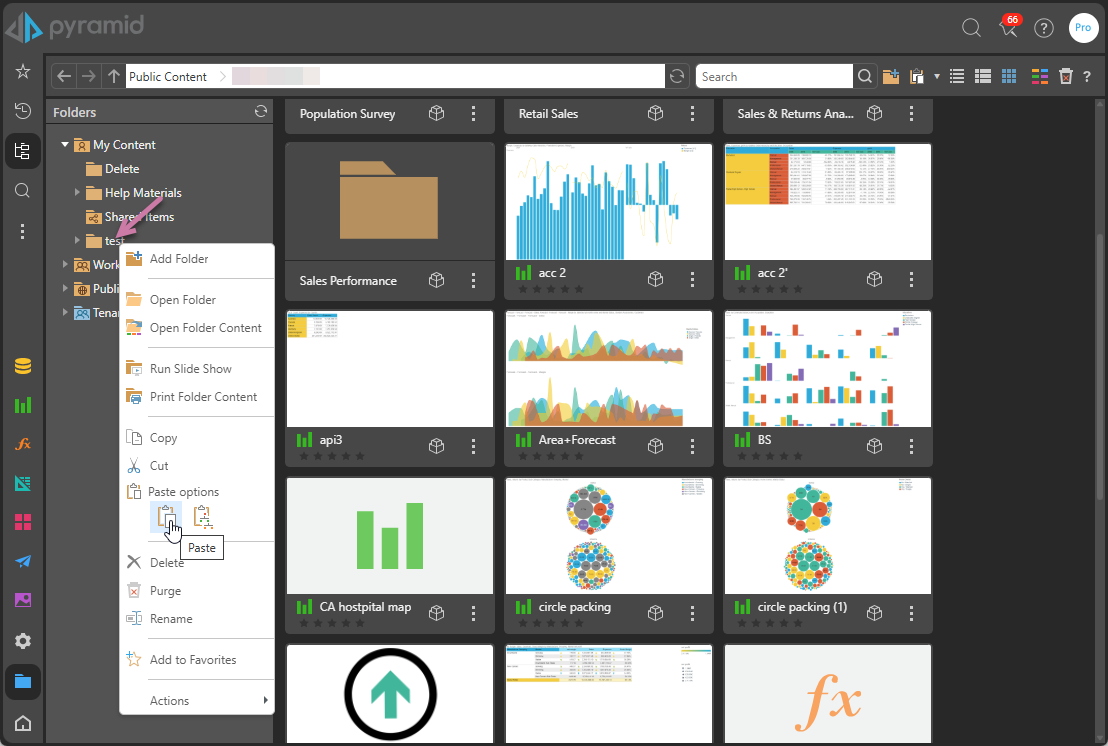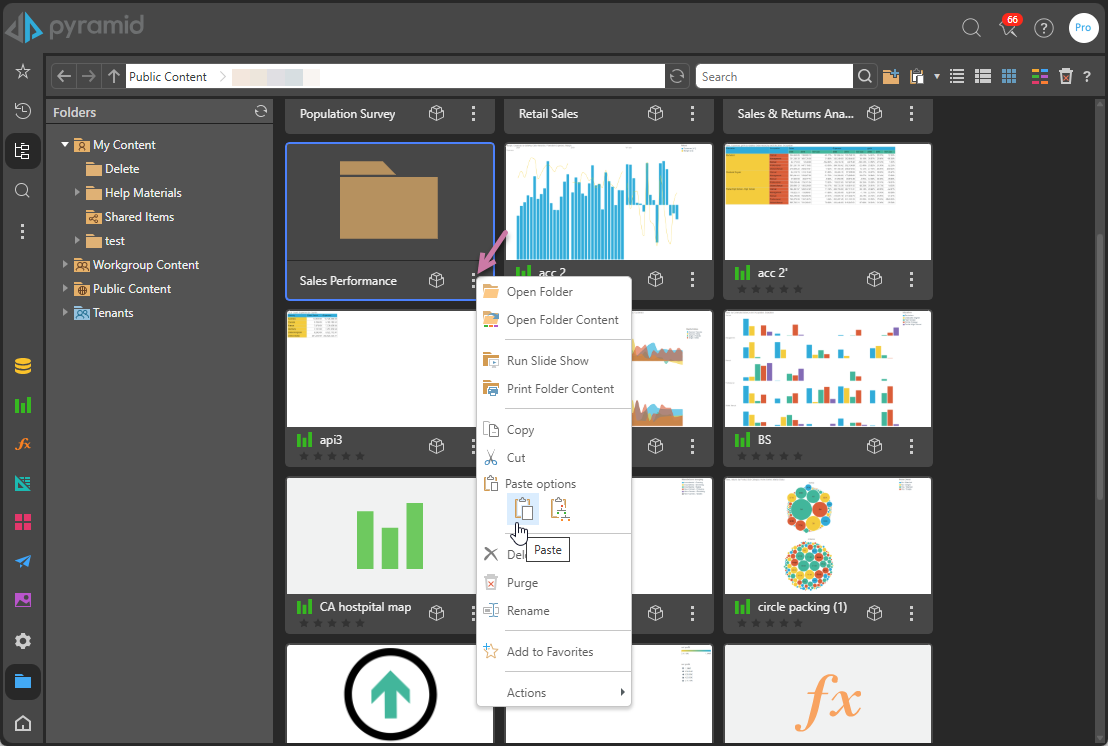The copy-paste functionality in the Content Manager operates like other copy-paste functions in other applications and tools, for example Windows explorer. Since its main function is to duplicate content from one part of the file system to another, the copy paste functions are mainly used within the Content Explorer view. However, it is possible to copy from any other view into the content manager, while the paste operations will be limited to the explorer view only.
Note: This functionality is available for all user types, each with some tailored functionality. Click to learn more about Analyst access.
Copying and Pasting
Copy
The first stage when using copy-paste is to select the items that should be copied. Users can simply right-click on any content item or folder in ANY of the content views and choose "copy" from the context menu (see item actions and folder actions). Multiple items can also be copied by first selecting them and then choosing copy from the context menu.
Once selected, the item listing is held in memory until a paste operation is performed or until another competing copy (or cut) operation replaces the selection in memory.
Configuring Clipboard Mode
When copying raw data to the clipboard, the format used is defined by your Clipboard Mode (configurable in your User Defaults). If you typically paste your raw data into a Microsoft file (such as Microsoft Excel Spreadsheets), you should select Microsoft Compatible. If you typically paste your raw data into Google Docs (such as Google Sheets), you should select Google Docs Compatible.
Paste
The next stage is to paste the items to trigger the duplication. Crucially, this can only happen in the Content Explorer view, since all other views are filtered lists of items, rather than folder containers and destinations.
The choice of using the "simple" paste versus the "deep" paste option is driven by the duplication goal. This is explained in the mechanics section below.
In the Content Explorer, you can:
- Right-click the canvas and choose one of the paste options from the context menu to paste the items into the currently selected folder:
- Right-click a folder in the tree and choose one of the paste options from the context menu to paste the items into that specific folder:
- Click the menu for a sub-folder item in the item listing panel and choose one of the paste options from the context menu to paste the items into that specific folder:
- Use the paste options in the Content Explorer's Navigation Bar.




Copy-Paste Mechanics
While copying items from one folder to another is simple process, the underlying mechanics in Pyramid are more complex. This is because items can include other nested objects and items, which in turn can also nest other objects and items. The hierarchical content model means that the copy-paste operation needs to behave with smarter mechanics than just a simple duplication framework.
To resolve this problem, the content manager allows users to either do a paste or a deep paste operation. To explain this, we will use the example of a Present dashboard (and its lineage diagram shown below) which has multiple green Discover visualizations and a purple Illustrate object in its structure. Note: Some of the Discover items also contain orange Formulate calculations (gross margin).

Paste
Using the example above, a user copying the dashboard (red) item and then choosing the simple paste option will ONLY DUPLICATE the red Present file. All the other items are not copied and instead become SHARED between the original dashboard and its duplicate. This is a form of referential content copying, where the file structures are referenced multiple times, rather than fully duplicated.
The simple paste, therefore, is used when the dashboard itself needs to be duplicated without duplicating any of the content embedded inside it.
Simple pasting encourages content-reuse and sharing.
Deep Paste
The deep paste option is designed to make both a duplicate of the item and a duplicate of all the subordinate content items used or embedded in the items as well. In our example, the entire tree of items is duplicated and copied to the new destination. In the process, the new dashboard is "rewired" to point to the new copies of the green Discover reports and the new copy of the purple Illustrate objects. Likewise, the new green Discover reports are also rewired to look at the new copies of the orange Formulate calculations.
The deep paste, therefore, is used when users want to make a full duplication of an entire collection of conjoined analytical objects and to consolidate the elements into one location.
Deep pasting discourages content-reuse and sharing but makes it easier to create more controlled and consolidated analytical content projects.
Move to Destination
If your paste would create duplicate content items at the target location, you can use the Move to Destination dialog to tell Pyramid how to resolve any potential import conflicts. This ensures that you do not end up with duplicate files or IDs, or an unwanted proliferation of identical files.
The Move to Destination dialog box includes the following options for each file or folder reporting a clash:
Replace Files
(Files only.) Replace each duplicate item at the target with the new item from the source. The source item overwrites the target item and the new item (the result of the replacement) has the same name and content ID as the old item.
Bookmarks
Bookmarks are not copied between files (discoveries or presentations) in a copy-paste or import. However, where both your original and replacement files contain the same slicer type (for example, a Country slicer), Pyramid keeps the bookmarks from the original file. This means that, when replacing an OLD file with a NEW file, if both contain the Country slicer, the bookmarks associated with the OLD file are kept. If your OLD and NEW files contain different slicers (for example Country in OLD and Age in NEW), then the bookmarks are deleted.
Note: The action taken by Pyramid is reported as the Bookmarks Status once the replacement is complete. If the icon is Gray, there were no bookmarks; Green, means all slicers matched and bookmarks have been successfully kept from the old files; Red, means all bookmarks were deleted; and Orange means one or more bookmarks were deleted and one or more were kept. Hover over the Status icon to see the action taken by Pyramid.
Schedules
Schedules are also not copied between files in a copy-paste or import. Where both NEW and OLD files are scheduled to run with the same slicer type (for example, a Country slicer), Pyramid continues to run the schedule from the NEW file after the replacement has been completed.
Note: Again, the action taken by Pyramid is reported once the replacement is complete, but this time as the Schedules Status. The colors reflect the same success (Green), partial (Orange), and delete (Red) outcomes described for bookmarks by Pyramid.
Merge files
(Folders only.) Where there are duplicate items, replace the items at the target with new items from the source as described above. Where there are new source items, copy them to the target. Where there are existing items on the target that are not present at the source, leave them unchanged. In short, replace duplicate items, add new items, and leave existing items unchanged.
New
Where there are duplicate items, keep both old and new items. Rename the new (source) item by attaching a suffix and, if the item shares the same content ID as a target item, also assign it a new ID.
Skip
Ignore this item and move on to the next, leaving the target file unchanged.
Tip: Select the Apply to All checkbox before you click one of the options to apply your selection to all of the clashing items and folders.